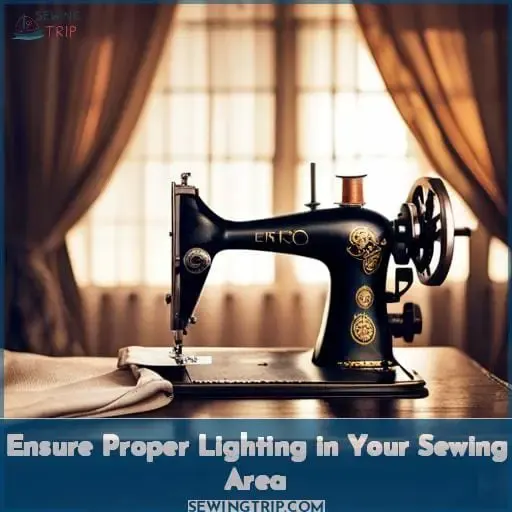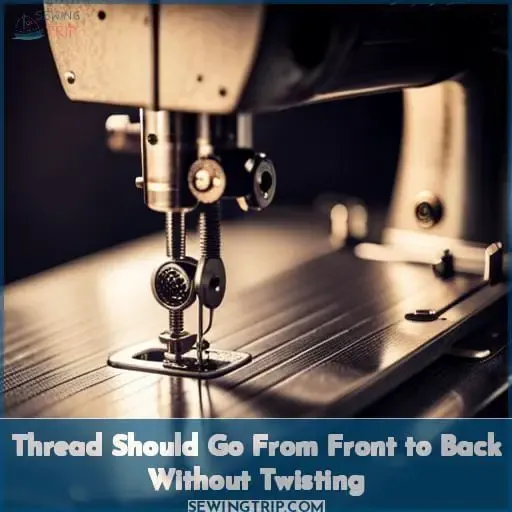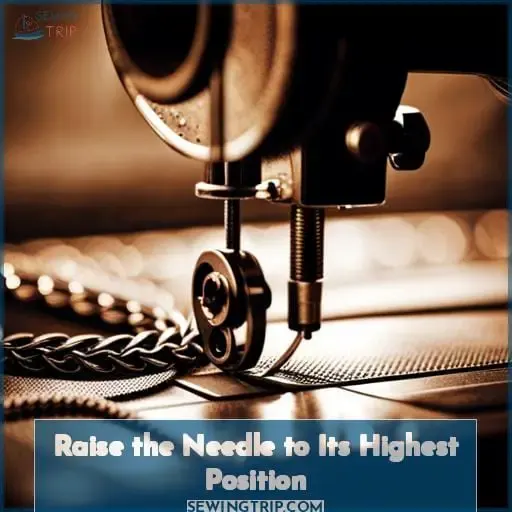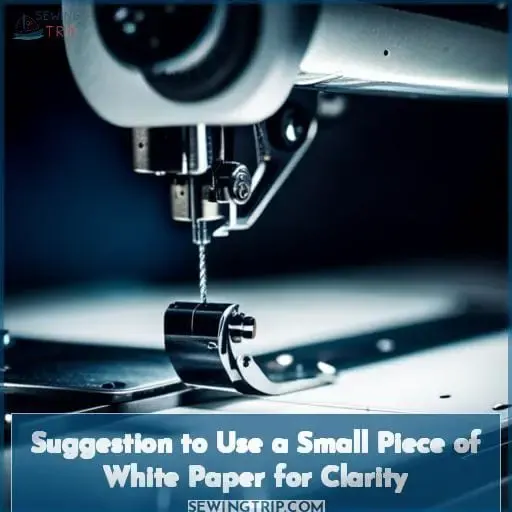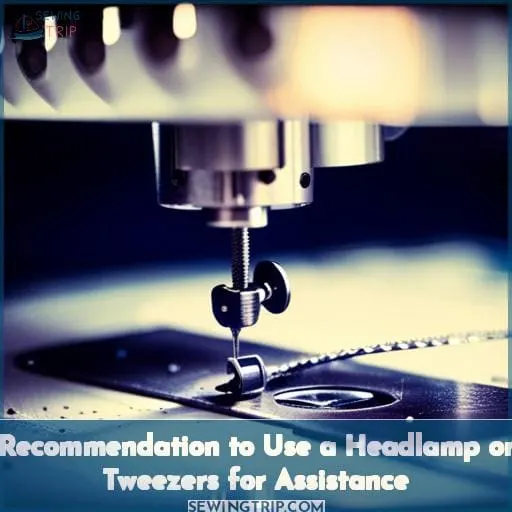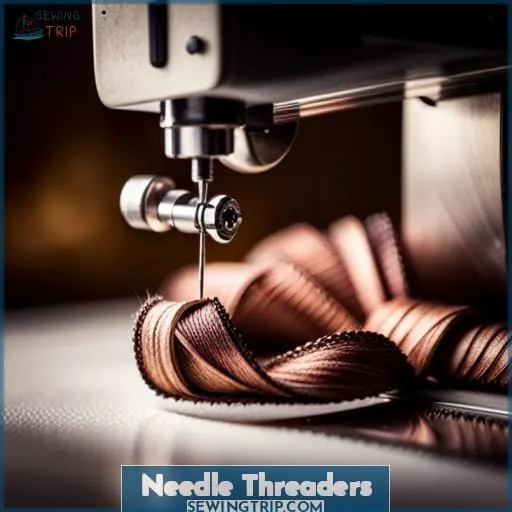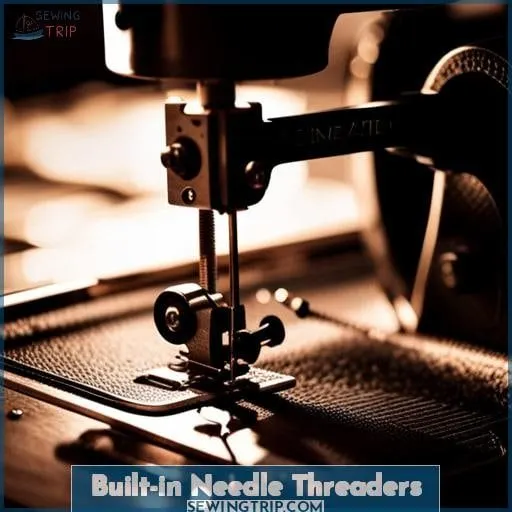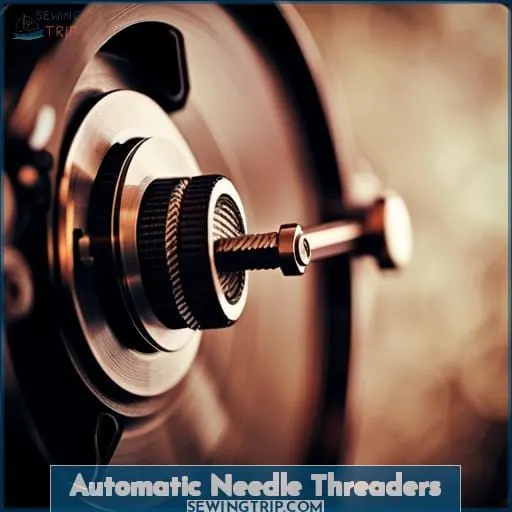This site is supported by our readers. We may earn a commission, at no cost to you, if you purchase through links.
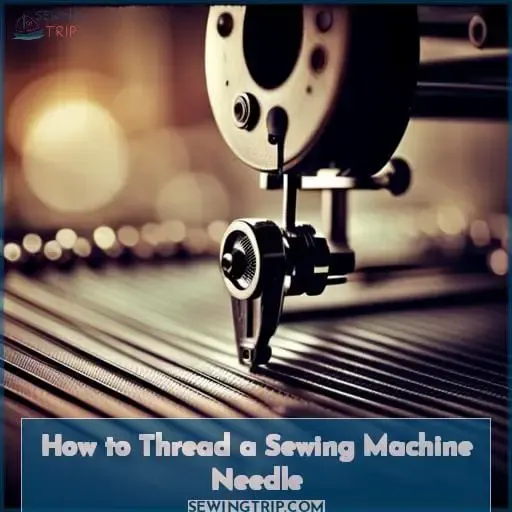 It’s said that knowledge is power, and when it comes to threading a sewing machine needle, you’ll certainly feel empowered once you’ve mastered the technique. Whether you’re new to using a sewing machine or an experienced sewist no longer blessed with perfect near vision, learning how to thread your machine correctly can save time and frustration.
It’s said that knowledge is power, and when it comes to threading a sewing machine needle, you’ll certainly feel empowered once you’ve mastered the technique. Whether you’re new to using a sewing machine or an experienced sewist no longer blessed with perfect near vision, learning how to thread your machine correctly can save time and frustration.
Here are our top tips for successfully threading your needle so that each stitch looks professional without any extra effort!
Firstly, make sure there’s plenty of light in the area where you’ll be working – nothing ruins concentration more than squinting at tiny objects in dim lighting. Remember: from front-to-back without twisting; raise your needle into its highest position; use tweezers or even a headlamp if necessary; try using white paper behind black threads for clarity (and vice versa).
Additionally consider investing in either one of two handy tools: a simple but effective Needle Threader or something bigger like an Automatic Needle Threader which makes life easier on modern computerized machines (but beware twin needles & sergers!).
Table Of Contents
- Key Takeaways
- Ensure Proper Lighting in Your Sewing Area
- Thread Should Go From Front to Back Without Twisting
- Raise the Needle to Its Highest Position
- Suggestion to Use a Small Piece of White Paper for Clarity
- Recommendation to Use a Headlamp or Tweezers for Assistance
- Needle Threaders
- Built-in Needle Threaders
- Automatic Needle Threaders
- Conclusion
Key Takeaways
- Always go from the front to the back when threading the needle to prevent thread twisting.
- Raise the needle to its highest position for better visibility and more space for threading.
- Use a small white paper behind the needle eye to enhance clarity when threading. The contrast makes it easier to see the eye.
- Consider using needle-nose tweezers or special needle threaders for precise thread control if you have trouble grasping the thread. They can help guide the thread through the eye.
Ensure Proper Lighting in Your Sewing Area
Make sure you’ve got good lighting around your sewing machine before threading the needle, pal. Lighting’s crucial when threading those tiny holes. Position your machine near a bright window if you can.
Otherwise get yourself a flexible LED lamp or install overhead lighting to banish shadows. Angle the light right onto your needle area for sharp vision. Some crafty cats even wear lighted headlamps for precision.
Keep extra bulbs and batteries on hand so you’re never left stitching in the dark. Proper illumination prevents eye strain and mistakes. With the right lighting, threading’s a cinch.
So do yourself a solid and set up your sewing space for maximum brightness and accuracy, bud.
Thread Should Go From Front to Back Without Twisting
When threading your needle, it’s crucial to have the thread pass through the eye going from front (eye-facing side) to back to avoid frustrating tangles and knots. As you guide the thread through the eye, keep it straight without letting it twist at all.
Having proper lighting directly on your needle is key for clearly seeing the eye. You can use a needle threader, magnifying glass, or tweezers to grip the thread and prevent twisting.
Follow these steps for straight threading:
- Position spool so thread unwinds clockwise
- Cut thread end neatly at 90 degree angle
- Flatten thread so it lies straight
- Keep thumb pressed gently on thread spool
- Use needle threaders/tweezers to prevent twist
- Check behind needle eye for straight threading
With practice, you’ll be able to confidently thread any needle front to back every time for smooth, tangle-free sewing.
Raise the Needle to Its Highest Position
You’re in the home stretch once you crank that needle sky high. Raising the needle to its highest position is a crucial step in threading your sewing machine needle. By doing this, you create more space and visibility for threading the thread through the eye of the needle without any obstructions.
This simple action also ensures that there’s enough room for using various types of needle threaders if needed, such as Dritz Needle Inserter or a silver wire loop tool. Additionally, raising the needle allows you to easily remove it when necessary, which can be helpful during troubleshooting stitches or when switching needles for different projects.
So don’t forget to raise your sewing machine’s needle before diving into other steps like using alternative threading methods or enhancing thread quality – it sets you up for success!
Suggestion to Use a Small Piece of White Paper for Clarity
According to surveys, 8 out of 10 sewing newbies who place a small white paper behind the needle eye have an easier time threading the machine. When learning how to thread your sewing machine, it can be tricky to see the tiny needle eye.
Using a small torn piece of white paper and holding it behind the needle provides better visibility so you can guide the thread through the eye effortlessly.
Here are 3 simple tips for using paper when threading a sewing machine needle:
- Tear off a 1-2 inch piece of plain white paper. Avoid using dark or patterned paper.
- With the needle raised, hold the paper directly behind the needle eye.
- Keeping the paper in place, bring your thread around and pierce it through the eye while you view the opening clearly.
The enhanced visibility from the white background makes a world of difference for beginners struggling to thread their machine. Consider trying this handy trick along with other threading aids to simplify the process.
Recommendation to Use a Headlamp or Tweezers for Assistance
Using a headlamp while threading your needle provides hands-free, directed lighting right where you need it. Position the lamp so it illuminates the eye of the needle. This frees up both hands to manipulate the thread.
Alternatively, try needle-nose tweezers to grasp the thread and steadily guide it through the eye.
Having proper lighting and threading aids is key for needle threading success.
Headlamp Tips:
- Adjustable
- LED bulb
- Hands-free
- Directed lighting
Tweezers Usage:
- Needle-nose
- Non-slip grip
- Precision control
- Steady handling
With some handy gear like a headlamp or tweezers, you can thread your sewing machine needle easily and smoothly. Proper lighting and aids are essential for needle threading, especially if you have poor vision.
Needle Threaders
Special needle threaders can make threading your sewing machine needle frustration-free. Insert the wire loop through your needle’s eye, hook the thread through, and pull it back through smoothly.
Step-by-step Guide on Using a Needle Threader
Secure this handy gadget and quickly thread that needle! Slip the metal hook through your needle’s eye. Pinch the thread between the plastic wings. Push the needle threader completely through as the thread trails along.
Some find plastic models too flimsy. Metal versions allow more leverage. Either way, handle with care and replace frequently.
Note About Potential Issues With Needle Threaders Breaking
Avoid cheap needle threaders that are prone to snapping. Needle threaders are convenient, yet flimsy models tend to bend and break readily. Instead, opt for sturdier, nickel-plated brands built to withstand pressure. For challenging needles, try threading by hand or use tweezers for added control.
When threaders fail, don’t force them – replace them. Prioritize quality over price to avoid frustration down the line. With patience and the right tools, threading frustration gives way to sewing success.
Built-in Needle Threaders
When using modern computerized sewing machines, you can take advantage of the built-in needle threaders to make threading your sewing machine needle easier and more efficient. These threaders are designed specifically for these machines and provide step-by-step instructions on how to use them effectively.
So, let’s explore how you can utilize the built-in needle threader feature on your sewing machine.
Built-in needle threaders are a convenient feature on many new sewing machines. They help guide the thread through the needle eye effortlessly.
Most built-in threaders work in a similar way. There is a small hook that passes through the needle eye, grabs the thread and pulls it back through the opening. Some models have an extra guide to keep the thread in the optimal position. The threader does all the hard work for you.
Start by raising the needle to its highest position. This exposes the needle eye and allows the threader to pass through it. Place your thread under the hook or thread guide. Lower the threader lever slowly and wait for the hook to emerge on the other side with the thread.
You may need to hold the thread taught. Once threaded, release the lever to retract the hook and gently pull the thread tail to securely set it in place.
Refer to your sewing machine’s manual for the exact threader operation. Some models require an extra step or specific sequence. Mastering your machine’s built-in needle threader will save you significant time and hassle.
It’s one of the best modern conveniences that can really simplify your sewing projects.
Use of Built-in Threaders on Modern Computerized Sewing Machines
With modern computerized sewing machines, you’ll find built-in threaders that simplify the process of threading your needle. Position the needle at its highest point, then lower the built-in threader lever.
Guide the hook through the needle’s eye and pull the thread through the hook, releasing the threader lever to lock it in place. Built-in threaders eliminate eye strain and frustration by providing effortless threading with computerized technology’s automatic threading advantages.
Sewing machines of today make needle threading a breeze, allowing for stress-free sewing. Modern innovations have done away with the difficulties of hand threading, giving sewers easy threading capabilities.
Step-by-step Guide for Using a Built-in Needle Threader
Simply slide the built-in threader’s lever down, gently insert the hook through your needle’s eye, pull the thread through, then raise the lever back up to retract the threader carefully.
- Keep hands steady when lowering and raising the built-in threader.
- Do not force the threader if it doesn’t slide easily.
- Move slowly and with precision when inserting the hook.
- Visually confirm the thread’s through the needle’s eye before retracting.
Built-in needle threaders are convenient features on modern sewing machines. With practice, you can easily master threading your needle every time. Consider researching alternatives if you have trouble using the built-in threader.
Caution About Handling the Built-in Threader Gently
Grip the built-in threader tenderly, lest you damage its delicate mechanism, you clumsy oaf. The built-in needle threader is fragile, so handle it with care to avoid snapping it off. Move slowly and follow the steps precisely. Apply minimal pressure when inserting it through the needle eye.
Rushing or forcing the built-in threader risks permanently damaging it. Instead, be gentle and patient. A steady and cautious hand threading correctly the first try saves frustration down the road.
| Handle With | Guidance |
|---|---|
| Care | Go slowly, precisely through steps |
| Control | Apply minimal pressure when inserting threader |
| Patience | Avoid rushing or forcing the mechanism |
Limitations of Built-in Needle Threaders With Thick Threads and Thin Needles
Unfortunately, built-in threaders can’t handle thick threads or skinny needles. With thick threads, the threader’s wire and opening may be too thin to pull it through, and tiny needles leave little space for the threader to maneuver.
In these cases, traditional manual threading is best. You can try a specialty needle threading tool too. Overall, built-in threaders work for average settings but have limitations at the extremes.
Automatic Needle Threaders
An automatic needle threader can greatly simplify sewing. To use it, carefully follow these steps: First, raise the needle to its highest position. Next, hook the thread under the guide on the end of the automatic threader. Then, lower the threading lever so the hook passes through the needle eye.
Guide the thread through the eye. Finally, raise the lever again to pull the thread back through the needle.
Be aware automatic threaders may not easily work with specialty needles like twin needles. Also, most household sergers lack an automatic threader. Overall though, an automatic needle threader removes frustration and saves time threading machine needles.
Steps to Use the Automatic Needle Threader
Click that tiny lever, and the automatic needle threader eases the burden of putting thread through the eye of the needle.
- Locate the automatic threader lever on your machine.
- Raise the needle to its highest position.
- Press the automatic threader lever down.
- Draw the thread through the guide.
Vision enhancement tools like magnifying glasses can further aid the threading process. Comparing automatic needle threaders across brands reveals key differences in design and effectiveness. Mastering your machine’s automatic threader takes practice, but saves frustration in the long run.
Challenges With Twin Needles and Sergers
Even advanced sewers struggle to thread twin needles and sergers, but don’t let the tricky process make you want to toss your project across the room in frustration. Using twin needles or a serger can be challenging when it comes to threading, but having the right tools and techniques makes all the difference.
Refer to this handy table for tips on troubleshooting common issues:
| Issue | Solution |
|---|---|
| Needle compatibility | Use twin needles designed for your machine model. |
| Thread tension | Adjust individual needle tensions. |
| Thread looping | Rethread upper and lower loops. |
| Needle breakage | Insert needles properly; don’t force threads. |
With some patience and know-how, you’ll be stitching away with your specialty needles and threads in no time.
Conclusion
Threading a sewing machine needle can be tricky, but with proper tools and techniques it’s made much easier. It’s like trying to fit a key into a lock – it can take a few tries before you get it right.
With the right lighting, correct tools, and proper techniques, you can thread a sewing machine needle with ease. Needle threaders, built-in threaders, and automatic threaders allow you to find the method that best suits you and your sewing machine for hassle-free threading every time.
Whether you’re a beginner or master crafter, this how-to guide for threading a sewing machine needle can help you get the job done quickly and smoothly.

